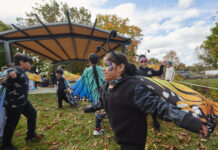
March is National Reading Month. When you were a child, did you have a love for books and the array of universes that reading opens? Promoting literacy is particularly important, especially in a society that may not always inspire the enthusiastic consumption of books.
According to 2020 results from a National Assessment of Educational Progress report, “The percentages of 9-year-olds and 13-year-olds who report that they ‘never or hardly ever’ read for fun have increased significantly since the question was first included in the questionnaire in 1984.” This sobering reality of the modern age underlies the importance of nurturing early readers and introducing future generations to the sense of wonder found in the pages of a book.
In recognition of National Reading Month, we spoke with experts on the importance of diverse, enthusiastic childhood reading and how parents can raise children with healthy appetites for books.
Read to Kids at an Early Age
According to Conni L. Strittmatter, youth and family engagement manager at Baltimore County Public Library in Maryland, “Literacy skills begin on day one for children.” While children don’t need to be reading or sounding out letters at birth, “it does mean that kids start their lives ready to absorb all the information around them, including a love of reading
and learning,” she says.
When parents read to their children (even infants), they plant the seeds for a love of reading and learning. They are also “exposing them to fundamental components of language and reasoning that will form a base for their overall education,” she adds.
Childhood reading holds great importance, explains Tora Burns, reading programs manager at the DC Public Library. Reading builds confidence and vocabulary, and it helps young brains develop.
“It teaches (children) how they interact with the world,” she notes. In addition, “Reading with a trusted adult as children age helps create positive memories that build resiliency and combat adverse childhood experiences.”
Jenny Bogoni, executive director of Read by 4th, oversees a Philadelphia coalition of family, community and systems leaders aiming to protect every child’s right to read.
She emphasizes the vital nature of childhood literacy.
“The research shows that children who are not reading on grade level by the time they complete third grade are significantly less likely to graduate high school on time and therefore less likely to move on to college and get a postsecondary credential of some kind.” Schools, she adds, are set up to teach children how to read up through third grade. After third grade, instruction shifts from teaching the “skill” of reading to practicing reading and using reading to access content.
“When children are not on grade level with their reading, it doesn’t just hinder their English participation in class. It hinders their math, science, history and everything else,” explains Bogoni. Reading is an important “gateway skill,” and reading often strengthens a child’s reading ability, much like practicing is key to becoming a good pianist. Bogoni adds that reading opens children to a world of ideas, concepts and knowledge that will allow them to perform better on standardized tests.
Read Diverse Books
Reading as a standalone concept is vital for children, but so is what children read.
“Ideally, every child should be able to find a book that resonates with them,” says Burns. “Diversity in children’s books helps young leaders develop pride in themselves as well as empathy
and appreciation for people who may have different lived experiences.”
Strittmatter agrees. “Media of all types, including books, should provide opportunities for people to see themselves reflected in some way.” Unfortunately, she notes, while books are “a primary way children learn about and connect to the world,” more children’s books featuring animals as main characters exist compared to children’s books published that feature non-white main characters, according to statistics compiled by the Cooperative Children’s Book Center, School of Education, University of Wisconsin-Madison.
“When (children) can’t find themselves in those books, they’re hearing a message that they don’t matter in that world,” Strittmatter says. “For white children only seeing characters that look like themselves, the message may be that ‘only they matter.’” This point underscores the importance of encouraging children to read diverse books. “Diverse books provide an opportunity for children to see value in themselves and value in others who may not look like them,” she adds.
Read Together
What can parents do to help raise strong readers among their children?
“The first thing a parent can do is actually model a reading household,” explains Bogoni. Parents should “have books of their own, show enjoyment around reading, make reading something that kids want to do,” she says. When reading with children, parents should stop to ask questions. “What does this remind you of in our life?” “Have you experienced anything like this?” “What do you see on this page?” These questions engage children and build language alongside connection and joy.
“Reading can become linked to schoolwork and homework when our children go to school,” Burns notes. Therefore, she emphasizes, parents need to help their children remember that reading is also a pleasure.
“When reading is seen as fun and continues as a leisure activity, children have more confidence in learning new information from the written word,” Burns explains.
To help build a love of reading outside the classroom, Burns encourages parents to embrace all forms of reading — reading online, reading picture books and reading graphic novels — to allow children to discuss their reading, explain what they’ve learned from a story and read what they love to read.
Reading Resources From Your Community Libraries
Jenny Bogoni, executive director of Read by 4th, points Philadelphia families to readingpromise.org, where they can find “The Five Reading Promises,” a framework of patterns
and habits to help raise readers.
To get more involved with childhood literacy in your neighborhood, visit volunteer.readby4th.org for volunteer opportunities such as “Reading Captains,” a chance to become an early childhood literacy expert and advocate for your neighborhood.
Explore the Free Library of Philadelphia’s website (freelibrary.org) for information about nurturing children’s love for reading and registering for a library card.
Locate your local library by visiting the following websites:
- Delaware: lib.de.us
- New Jersey: njstatelib.org
- Pennsylvania: statelibrary.pa.gov/libraries/pages/public-libraries.aspx






